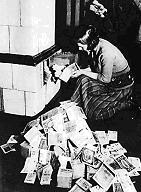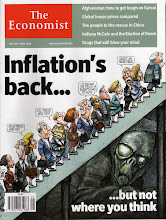

Inflation reached 624% in early 2004, then fell back to low triple digits before surging to a new high of 1,730% in March 2007. In June 2007 the government released the latest figures of 7,638%. The predictions for the annual inflation range from 3,000% (according to the IMF) to 8,000%. The Reserve Board of Zimbabwe has in part blaimed rampant inflation on the slow distribution of larger notes causing inefficiency in exchange (thus lowering productivity). In early May 2006 the government printed around 60 trillion Zimbabwe dollars (In February it printed 21 trillion to borrow foreign money). In February 2007 certain price rises on commodities were declared illegal. In June 2007 the estimate of inflation (Month on Month) was 11,000%. The IMF estimates over 100,000% for January 2008. New notes have been issued superseeding ones intended to last until the 30th June 2008.
As of May 2008 the highest note is 500 million.
The 25 million note shown above contains a 500 watermark (a common thread amongst the notes, the German printers currently providing the Bearer Cheques provided the notes prior to the inflation problems, and used the already made watermarked paper. For example, the 750,000 dollar note contains the 1000 dollar watermark.)
In 1980 the Reserve Bank of Zimbabwe replaced the Reserve Bank of Rhodesia and the Rhodesian Dollar was replaced with the Zimbabwe dollar.
In 2003 the Reserve Bank began to print Bearer Cheques with limited periods to validity.
In 2006 the Dollar was revalued under Dr Gideon Gono's (Governor of the Reserve Bank) Sunrise Operation, and only Bearer Cheques were printed.
http://www.rbz.co.zw/pdfs/highDenom2.pdf < - Release of the 10,000,000 Dollar Cheque, from the 18th January 2008.
http://www.rbz.co.zw/pdfs/special_agro.pdf <- Release of new Billion dollar denomination Agro Cheques.
http://www.rbz.co.zw/pdfs/Sunrise2.pdf <- Launch of the Sunrise 2 operation in November 2007 to clamp down on presumed cash shortages. As well as give advanced warning of the intent to remove zeros from the currency. ("we advise that such preparation includes simulations for the removal of 1, 2, 3 or even 4
zeros from the current set of legal tender") This has to date not occured.
http://www.rbz.co.zw/pdfs/bearer.pdf <- Earlier release of cheques.
As of the current date the highest note denomination is 500,000,000 Zimbabwe Dollars, this should expire on the 31st of December 2008.
The notes above
Are signed by the current Governor Dr G. Gono. The 25 million note contains a watermark of '500', whereas the 10 million note contains a RBZ watermark, as well as the symbol of the bird. The 25 million note has a security strip in the centre with 'RBZ 500' written along it. The 10 million with just 'RBZ' written along it.
Zimbabwe Bird Watermark (National Emblem):

The back of the 10 million has a Tiger Fish and the Kariba Dam on the back.
The notes are printed presumably by G&D (Giesecke & Devrient) Printers, and the 10 million note was issued in January (18th) of 2008. The 25 million note in April (2nd)2008.






